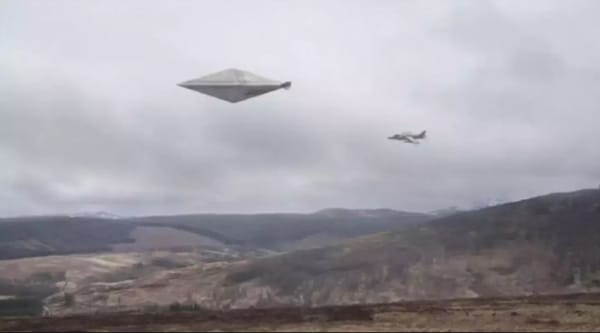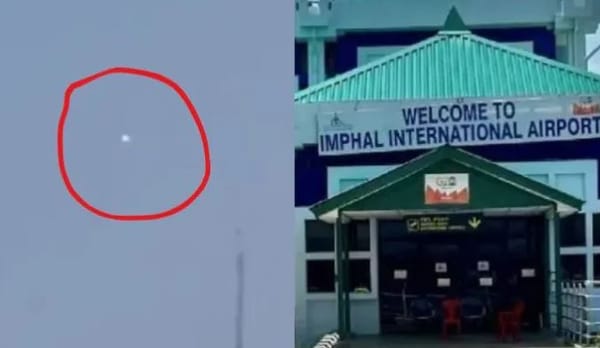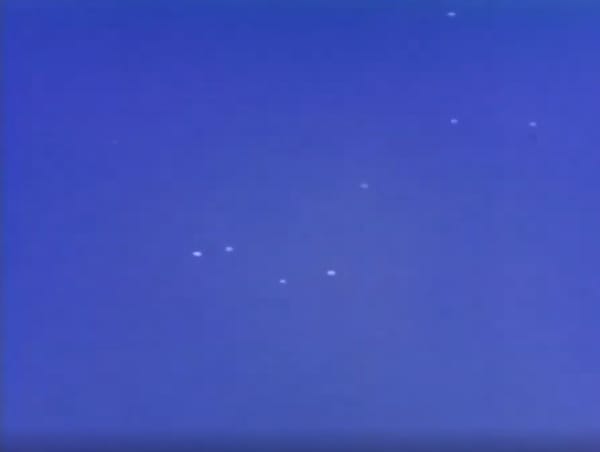The 1980 Rendlesham Forest Incident

The Rendlesham Forest UFO incident, which took place in December 1980, stands as one of the most compelling and controversial events in the annals of UFO lore. Situated in the serene Suffolk countryside of England, this incident involved a series of mysterious sightings and encounters reported by U.S. military personnel stationed at nearby bases. Over two nights, airmen witnessed an unidentified craft displaying extraordinary maneuvers and emitting strange lights, leading to a flurry of official reports and subsequent investigations.
This incident holds significant weight not only in UFO lore but also in military history. It is often compared to the Roswell incident of 1947 due to its involvement of high-ranking military witnesses and the complex web of official scrutiny and secrecy that followed. The Rendlesham Forest case has become a focal point for discussions on government cover-ups, extraterrestrial encounters, and the intersection of military protocol and unexplained phenomena. As we explore the details of this enigmatic event, we'll uncover its impact on both UFO research and our understanding of military engagement with unexplained aerial phenomena.
Background
The Rendlesham Forest UFO incident unfolded in the picturesque and tranquil surroundings of Rendlesham Forest, located in Suffolk, England. This wooded area, known for its natural beauty and serene environment, became the backdrop for one of the most intriguing UFO encounters in modern history.
The events took place over the course of two nights in December 1980. During this period, personnel from the United States Air Force, stationed at the nearby RAF Woodbridge and RAF Bentwaters bases, reported a series of unusual sightings and interactions with an unidentified flying object. These bases, part of the U.S. Air Force's strategic defense network in Europe, housed a number of high-ranking military officials and were equipped with advanced radar and communication systems.
Key figures in the incident included Deputy Base Commander Lieutenant Colonel Charles Halt, who played a central role in documenting and investigating the occurrences, and several other airmen who provided firsthand accounts of the strange phenomena witnessed in the forest. Their testimonies and the subsequent official reports form the crux of this mysterious and often debated event.
The Incident
Initial Sightings: December 26, 1980
The Rendlesham Forest incident began in the early hours of December 26, 1980, when a series of unusual lights were observed by U.S. Air Force personnel stationed at RAF Woodbridge. The initial sighting occurred around 3 a.m. when Airman First Class John Burroughs and Staff Sergeant Jim Penniston reported seeing a bright, pulsating light descending into the forest. As they approached the area, they noticed a triangular-shaped craft with a metallic surface that seemed to emit a soft glow.

The object was described as approximately 9 to 12 feet across, with a series of markings or symbols visible on its surface. The craft appeared to be stationary and hovered just above the ground before it ascended and disappeared into the night sky.

Description of the UFO Sightings and Encounters
The following night, on December 27, 1980, the sightings continued with additional reports from other personnel stationed at RAF Bentwaters. Lieutenant Colonel Charles Halt, who was the Deputy Base Commander, was alerted to the ongoing situation. Halt, accompanied by a small team, ventured into the forest to investigate. They encountered a series of lights in the trees and reported seeing a glowing, diamond-shaped object hovering among the trees. The craft was described as having a pulsating, multi-colored light and appeared to move silently through the forest.
During their investigation, Halt and his team experienced a range of phenomena including an unexplained increase in background radiation levels at the sighting locations, which was detected using a radiation meter. The team also observed strange markings on the ground, which some interpreted as impressions left by the craft's landing gear. The encounter lasted several hours and was accompanied by intermittent communications with the base, adding to the overall sense of urgency and bewilderment among those involved.
Follow-Up Experiences: December 27-28, 1980
The following night, December 28, 1980, additional sightings were reported, but the nature of the encounters was less clear. Some witnesses claimed to have seen a series of bright lights in the sky, while others reported strange, unexplained phenomena such as power fluctuations and unusual electromagnetic interference. The intensity of the sightings seemed to wane, but the impact on those involved was lasting. The incident left a profound impression on the airmen, who were deeply unsettled by their experiences.
In the aftermath, the incident was the subject of a significant investigation by the U.S. Air Force and other authorities. Despite numerous reports and testimonies, the official explanation remained inconclusive, leaving the Rendlesham Forest event one of the most compelling and enduring mysteries in the field of UFO lore.
Eyewitness Accounts
Detailed Accounts from Key Witnesses
- Colonel Charles Halt
Colonel Charles Halt, then Deputy Base Commander at RAF Bentwaters, played a pivotal role in documenting the Rendlesham Forest incident. On the night of December 27, 1980, Halt led a team into the forest after receiving reports of unusual lights. His account details a series of vivid and unsettling observations. According to Halt, they encountered a glowing, diamond-shaped object hovering among the trees. The craft emitted a pulsating, multi-colored light and moved silently. Halt described the object as being about 10-15 feet in diameter, with a surface that reflected light in a way that suggested a metallic or reflective material.
Halt’s account was meticulously documented in a memo he wrote shortly after the incident, known as the “Halt Memo.” This document, which includes his observations and measurements of radiation levels, is a cornerstone of the Rendlesham Forest evidence. He reported increased background radiation in the area where the craft was seen and noted that the radiation levels dropped back to normal after the object departed. Halt's observations were corroborated by the physical evidence of radiation readings and ground markings, adding credibility to his testimony.
- Staff Sergeant Jim Penniston
Staff Sergeant Jim Penniston was one of the first airmen to witness the strange lights on December 26, 1980. Penniston's account provides detailed descriptions of the craft he saw. According to Penniston, the object was triangular with a metallic surface and had markings or symbols on its exterior. He reported that the craft was about 9 to 12 feet across and hovered a few feet off the ground. Penniston approached the craft and observed it closely for several minutes. During this time, he claimed to have experienced a sense of mental communication with the craft, which left him with an overwhelming impression of an advanced, non-human technology.
Penniston’s description includes intricate details about the craft's appearance and behavior, and he later sketched the symbols he saw on the craft, which were reportedly like nothing he had encountered before. His account, along with his sketches, has been a significant point of reference for researchers and enthusiasts investigating the Rendlesham Forest incident.
- Others Involved
Several other U.S. Air Force personnel reported sightings and experiences related to the Rendlesham Forest incident. Their accounts provide additional perspectives on the events of December 1980. For instance, Airman First Class John Burroughs, who was with Penniston during the initial sighting, described seeing the same pulsating lights and the triangular craft. He reported a similar sense of awe and unease, and his recollections align closely with Penniston’s descriptions.
Other witnesses, including members of the base security team and officers on duty that night, reported unusual lights in the sky and strange occurrences such as power outages and electromagnetic disturbances. Although their accounts varied in specifics, they consistently described an anomalous and unexplained phenomenon that defied conventional explanations.
Variations in Reports and Observations
The eyewitness accounts of the Rendlesham Forest incident exhibit both consistent elements and notable variations. Key similarities include the descriptions of unusual lights, a metallic or reflective craft, and increased radiation levels. However, variations arise in the specifics of the craft’s appearance, behavior, and the exact nature of the encounters.
Some witnesses reported seeing different shapes or colors, while others noted different experiences of communication or interaction with the craft. These discrepancies contribute to the complexity of the incident and highlight the challenge of piecing together a cohesive narrative from multiple perspectives. Despite these variations, the convergence of multiple credible accounts underscores the significance of the Rendlesham Forest incident in UFO lore and military history.
Military Response and Investigation
Actions Taken by the U.S. Air Force
In response to the events at Rendlesham Forest, the U.S. Air Force undertook a series of immediate and subsequent actions to investigate the incident. On the night of December 27, 1980, Colonel Charles Halt and his team, including security personnel, were dispatched to the site after reports of strange lights and a possible unidentified flying object (UFO). The initial response involved a thorough search of the area, during which the team encountered the anomalous craft and took note of various physical and environmental changes.
Following the initial sightings, a formal investigation was launched. The U.S. Air Force conducted interviews with witnesses, gathered physical evidence, and analyzed the environmental data collected from the site. This included measuring radiation levels, examining ground markings, and documenting the testimonies of those involved. The investigation sought to determine the nature of the unidentified object and assess any potential threats or security concerns associated with it.
Official Reports and Memos
The most significant official document related to the Rendlesham Forest incident is the “Halt Memo,” written by Colonel Charles Halt. This memo provides a detailed account of the events as observed by Halt and his team, including descriptions of the craft, the radiation readings, and the ground markings. The memo also details the reactions of the witnesses and the steps taken during the investigation.
In addition to the Halt Memo, several other official reports and documents were produced, including summaries of witness interviews, environmental assessments, and evaluations of the evidence. These reports often contained standard military disclaimers and explanations, ranging from the mundane (such as the possibility of misidentified aircraft or natural phenomena) to the more speculative.
Analysis of the Military's Response and Conclusions
The U.S. Air Force’s investigation into the Rendlesham Forest incident was characterized by a standard military approach: thorough documentation, cautious evaluation, and a focus on security implications. The immediate response involved securing the area and assessing any potential threats, which reflects a protocol-driven approach to unexplained phenomena that could impact base security.
The official conclusions of the investigation were somewhat dismissive. The Air Force’s final assessments typically suggested that the sightings could be attributed to misidentified aircraft, unusual light conditions, or natural phenomena such as meteorological effects. However, these explanations were met with skepticism by many involved and outside observers, as they did not fully account for the detailed observations and physical evidence gathered during the incident.
The military’s response has been critiqued for not fully addressing the anomalies reported by the witnesses and for the apparent discrepancies between the official explanations and the evidence presented. The lack of a definitive explanation, combined with the detailed and consistent accounts from credible witnesses, has led to ongoing debate and speculation about the true nature of the Rendlesham Forest incident.
Overall, the military's response and investigation into the Rendlesham Forest incident reflect both a systematic approach to evaluating security concerns and an ongoing challenge in addressing and explaining unexplained phenomena. The incident remains a subject of interest and controversy, highlighting the complexities involved in military investigations of UFO sightings.
Evidence and Physical Evidence
Physical Traces and Environmental Impact
The Rendlesham Forest incident left behind several physical traces and signs that were carefully documented and analyzed. Key among these were the landing marks and radiation readings observed at the site.
- Landing Marks: Witnesses reported distinctive triangular impressions on the forest floor, which were believed to be the result of the alleged UFO's landing or hovering. These marks were characterized by a pattern of indentations and scorch marks in the soil. The shapes and dimensions of these marks were meticulously recorded by investigators, and their alignment and depth were analyzed to assess their authenticity.
- Radiation Readings: During their investigation, Colonel Charles Halt and his team detected elevated radiation levels in the area where the UFO was reported to have been sighted. These readings were taken using a Geiger counter, and the elevated levels were noted as anomalous compared to baseline measurements from other areas of the forest. The presence of increased radiation was considered a significant finding, as it could potentially indicate some form of high-energy emissions associated with the unidentified craft.
Photographs, Sketches, and Physical Samples
Documentation of the evidence included various forms of visual and physical records:
- Photographs: Although no clear photographs of the UFO itself were captured, the investigation included photographic documentation of the site, the landing marks, and the surrounding forest environment. These images provided a visual record of the physical traces and were used in the analysis of the site.
- Sketches: Witnesses, including Colonel Halt and Staff Sergeant Jim Penniston, created sketches of their observations. These sketches depicted the shape of the craft, the landing marks, and the overall layout of the site. The sketches were important for providing a visual representation of the events and were used in conjunction with other evidence.
- Physical Samples: Soil and vegetation samples from the area of the landing marks were collected for analysis. These samples were examined for any unusual characteristics, such as changes in soil composition or contamination. The physical samples were subjected to various tests to determine if they contained any residues or anomalies that could support the claims of an extraterrestrial encounter.
Examination and Analysis by Experts
The physical evidence collected from the Rendlesham Forest incident underwent scrutiny by various experts and analysts:
- Radiation Analysis: The elevated radiation readings were examined by experts in radiological science. While some suggested that the readings were indicative of a significant event, others argued that natural or man-made sources could have contributed to the increased levels. The challenge of attributing the radiation to a specific cause remained a point of contention.
- Soil and Vegetation Analysis: Scientists and forensic experts analyzed the soil and vegetation samples for signs of unusual contamination or alterations. While some tests suggested minor changes, no conclusive evidence was found that definitively linked the samples to an extraterrestrial craft. The results were often interpreted with caution, given the potential for natural or environmental factors to affect the samples.
- Witness Testimonies: The physical evidence was cross-referenced with the detailed testimonies of the witnesses. The consistency and credibility of the accounts, combined with the physical traces, contributed to the ongoing debate about the nature of the event. Expert analysis of the testimonies and evidence highlighted discrepancies and areas of agreement, contributing to the broader discussion of the incident.
Overall, the evidence and physical traces from the Rendlesham Forest incident provided a complex and intriguing puzzle. While some of the findings supported the claims of an extraordinary event, others remained inconclusive, leading to continued interest and debate among researchers, experts, and enthusiasts. The physical evidence, combined with witness accounts and expert analysis, remains a crucial component in the ongoing examination of this enigmatic event.
Conclusion
Summary of Key Points
The Rendlesham Forest incident, occurring over several days in late December 1980, remains one of the most compelling and controversial UFO encounters in history. Initial sightings reported by U.S. Air Force personnel included strange lights and an unidentified craft, leading to physical evidence such as landing marks and elevated radiation readings. Eyewitness accounts from key figures like Colonel Charles Halt and Staff Sergeant Jim Penniston, along with physical traces analyzed by experts, contribute to the enduring intrigue surrounding this event. Despite extensive investigation by the U.S. Air Force, including official reports and memos, the incident has left many questions unanswered and fueled ongoing debate.
Current Status and Legacy of the Incident
Today, the Rendlesham Forest incident continues to capture public and scholarly interest. It is widely regarded as one of the most significant UFO encounters involving military personnel. The site itself has become a focal point for UFO enthusiasts and researchers, who visit the location to explore the mystery further. The official military reports and declassified documents, coupled with the testimonies of those involved, have contributed to a broader understanding of the incident, though definitive explanations remain elusive.
The legacy of the Rendlesham Forest incident is marked by its influence on UFO lore and military history. It has inspired numerous books, documentaries, and studies, cementing its place in the annals of unexplained phenomena. The incident is frequently cited in discussions about the intersection of military secrecy, extraterrestrial theories, and the limits of conventional explanations.
Reflection on Its Place in UFO History and Military Encounters
The Rendlesham Forest incident occupies a unique position in UFO history due to its combination of credible witnesses, physical evidence, and military involvement. It stands out not only because of the detailed and corroborated accounts from trained military personnel but also due to the challenges faced in reconciling the findings with existing scientific and military knowledge. The incident's continued relevance highlights the ongoing fascination with unexplained phenomena and the complex relationship between military institutions and the pursuit of truth.
As a key case in UFO history, the Rendlesham Forest incident exemplifies the broader quest for understanding phenomena that defy conventional explanations. It serves as a reminder of the need for open-minded investigation and the importance of separating fact from speculation. Whether viewed through the lens of skepticism or belief, the incident remains a pivotal chapter in the ongoing exploration of our world’s most enduring mysteries.



